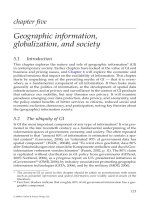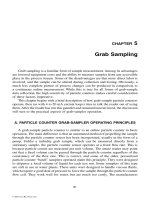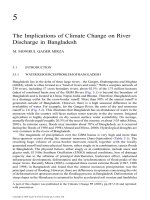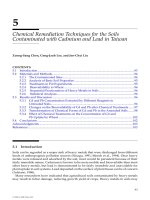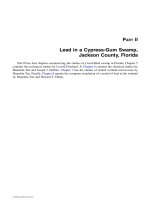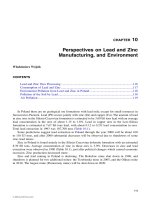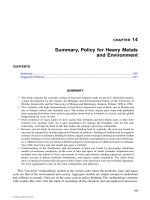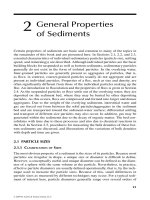ORGANIC SOILS and PEAT MATERIALS for SUSTAINABLE AGRICULTURE - CHAPTER 5 pot
Bạn đang xem bản rút gọn của tài liệu. Xem và tải ngay bản đầy đủ của tài liệu tại đây (125.44 KB, 12 trang )
CHAPTER
5
Soil Acidity Determination Methods for
Organic Soils and Peat Materials
Léon E. Parent and Catherine Tremblay
CONTENTS
Abstract
I. Introduction
II. Factors Influencing Soil pH Values
A. Soil-Solution Equilibration Time
B. Sampling Period
C. Soil-to-Solution Ratio
D. Moisture Condition
E. Suspension Media
III. Experimental Setup
A. Interactions between Suspension Media and Moisture
Conditions
B. Validation of Conversion Equations
C. pH Indicator of the Moorsh-Forming Process
IV. Conclusion
Acknowledgments
References
ABSTRACT
Soil pH is one of the most important and frequently measured chemical indicators
for assessing the quality of a soil for plant growth and microbial activity. The pH
is determined using different suspension media, soil-to-solution ratios, and soil
moisture conditions; therefore, conversion equations are presented in this chapter
© 2003 by CRC Press LLC
among methods for pristine and cultivated organic soil materials in this chapter. The
0.01 M CaCl
2
suspension was found to be the most reliable pH determination method
against variations in moisture content and initial dewatering conditions of peat and
moorsh materials. Compared with field-moist pristine peat materials, the air- or oven-
drying procedure decreased pH values by 0.37 in water, 0.08 in 0.01 M CaCl
2
, and
0.08 in 1 M KCl. The Shoemaker–McLean–Pratt buffer pH value was sensitive to
the moorsh-forming process. Whereas peat oven-drying (105°C) increased buffer
pH by 0.22–0.25 pH unit, moorsh oven-drying decreased buffer pH by 0.12 pH unit
compared with field-moist conditions. Change in buffer pH upon drying should be
further investigated to quantify the intensity of the moorsh-forming process in
organic soils after drainage and reclamation.
I. INTRODUCTION
One of the most important and frequently measured chemical indicators for
assessing the quality of a soil for plant growth and microbial activity is pH. Peat,
made of more than 30% soil organic matter (SOM), is the constituting material of
organic soils and is generally acidic. Peat materials form a complex of polycarboxylic
acids that exchange protons with cationic species on an equivalent basis (Bloom and
McBride, 1979). The origin of acidity in organic soil materials is related to the
degree of decomposition and botanical makeup of the peat. Long-chain uronic acids
rich in carboxyls predominate in fibric Sphagnum peat (Theander, 1954; Clymo,
1964). Humic and fulvic acids predominate in sapric peat (Naucke et al., 1990).
Lucas and Davis (1961) found the ideal pH (water suspension) for plant growth
to be 5.0 in Sphagnum peat, and 5.5–5.8 in wood-sedge peat. Hoffmann (1964)
specified a pH target of 4.3 in 1 M KCl for muck materials rich in clay and silt.
Kuntze and Bartels (1984) recommended a target pH (0.1 M CaCl
2
) of 4.5 for organic
soils showing 30–60% SOM and rich in clay and silt; they also recommended a
target pH of 4.0 for organic soils showing 30–60% SOM and rich in sand, as well
as for organic soils containing more than 60% SOM. Optimum pH (1 M KCl) value
was found to be 4.0 for onions and lettuce grown in organic soils (Van Lierop and
MacKenzie, 1975; Van Lierop et al., 1980).
Many factors influence the value of soil pH, such as moisture conditions, soil-
to-solution ratios, electrolyte concentrations, and the liquid junction potential
(Huberty and Haas, 1940; Peech et al., 1953; Schofield and Taylor, 1955; Collins
et al., 1970). The objective of this chapter is to document factors affecting pH
measurements in organic soil materials, and to present conversion equations among
determination methods.
II. FACTORS INFLUENCING SOIL PH VALUES
A. Soil-Solution Equilibration Time
Davis and Lawton (1947) equilibrated 50 field-moist moorsh samples (soil-to-
solution ratio of 1:1 v/v) with distilled water for 1, 15, or 60 min. Differences were
© 2003 by CRC Press LLC
small but significant, with average pH values of 5.70, 5.69, and 5.67, respectively.
Pessi (1962) found that the pH of eight field-moist pristine Sphagnum and forest
sedge peat materials decreased by 0.07 pH unit between 30 min and 3 h after mixing,
and stabilized after 7 h of equilibration. For air-dry mineral soils, a satisfactory pH
stability was reached after the first 1–2 h of equilibration (Ryti, 1965). Van Lierop
and MacKenzie (1977) did not report any significant effect of equilibration time (15
min vs. 60 min) on pH values of 10 field-moist or oven-dry moorsh samples. Van
Lierop (1981a) selected a 30-min equilibration period for pH measurements of 30
field-moist moorsh samples.
B. Sampling Period
Van der Paauw (1962) found that the pH of mineral soils decreased in periods of
low rainfall and increased in periods of high rainfall. Collins et al. (1970) found an
average seasonal variation of 0.8 pH unit for water suspension of field-moist mineral
soils, decreasing between June and September. In a Sphagnum peat limed at rates of
0 to 4 Mg ha
–1
, Pessi (1962) found an average pH increase of 0.39 pH unit in water
suspension and 0.09 pH unit in a 0.1 M CaCl
2
suspension, between June and October.
In the long run, Hamilton and Bernier (1973) found that pH (0.01 M CaCl
2
) of an
acid organic soil (initial pH of 3.57 in a 0.01 M CaCl
2
suspension in control plots)
tended to stabilize at 3.93, 4.48, 4.88, and 5.58 about 1.5 to 2 years after lime
application at rates of 0, 6.7, 13.4, and 26.8 Mg ha
–1
, respectively.
C. Soil-to-Solution Ratio
Peat bulk density is highly variable and poses a considerable challenge to soil
testing (Van Lierop, 1981b), including pH determination methods (Van Lierop and
MacKenzie, 1977). Davis and Lawton (1947) found a significant effect of three soil-
to-solution ratios on water pH values of 15 field-moist moorsh samples (P < 0.001):
the pH values averaged 5.36, 5.42, and 5.52 for the 1:0.5, 1:1, and 1:2.5 ratios,
respectively. Ryti (1965) used a 1:2.5 soil-to-solution volumetric ratio in a pH study
on air-dry pristine Sphagnum-Carex and wood-Carex peat samples. Van Lierop and
MacKenzie (1977) used 1:2 to 1:4 soil-to-solution volumetric ratios for field-moist
moorsh materials.
Van Lierop (1981a) obtained highly significant (R
2
= 0.998 to 0.999) relation-
ships between 1:2 and 1:4 volumetric ratios on pH values in 0.01 M CaCl
2
and 1
M KCl suspension media between 3 and 7 for 30 field-moist moorsh samples. On
average, differences were 0.024 and 0.110 pH unit for 0.01 M CaCl
2
and 1 M KCl,
respectively. For the 0.01 M CaCl
2
suspension, the relationship was as follows:
Y = 0.995X + 0.049 (5.1)
For the 1 M KCl suspension, the relationship was as follows:
Y = 0.98X + 0.21 (5.2)
where Y is the 1:2 ratio and X is the 1:4 ratio.
© 2003 by CRC Press LLC
Vaillancourt et al. (1999) compared 68 pH values of field-moist pristine peat
materials determined according to volume (1:4 v/v) and weight (3:50 w/v) ratios
(AOAC 1997). On average, the volume ratio (1:4 v/v) corresponded to a 1.4:50 (w/v)
air-dry weight to solution ratio, which was nearly half the ratio recommended by
AOAC (1997). Average pH differences between preparation methods (pH using 1.4:50
minus pH using 3:50 as air-dry weight to solution ratios) were 0.14
±
0.07 for water,
0.04
±
0.02 for 0.01 M CaCl
2
, and 0.12
±
0.02 for 1 M KCl. Thus, the 0.01 M CaCl
2
suspension showed the smallest pH difference, in keeping with Van Lierop (1981a).
These results support the view that the 0.01 M CaCl
2
suspension would provide more
stable pH values in peat and moorsh materials across a wider range of soil-to-solution
ratios when compared with water or 1 M KCl suspension media.
D. Moisture Condition
Rost and Feiger (1923) found that pH values of 17 acid mineral soils dropped
by 0.42 and 0.85 pH unit for air-dry and oven-dry samples, respectively, compared
to field-moist samples. Comparatively, the pH of four alkaline mineral soils
decreased by 0.54 and 0.32 pH units. The pH drop upon drying was irreversible
even when the soil was moistened again and equilibrated for a long period of time.
Soil pH should thus be taken under field-moist or natural conditions. Collins et al.
(1970) observed a larger pH drop in water than in 0.01 M CaCl
2
suspensions due
to air- or oven-drying 13 mineral soils.
Moisture conditions also influence the pH values of peat and moorsh materials
(Davis and Lawton, 1947; Kaila et al., 1954). Kaila et al. (1954) emphasized the
fact that the air-drying of peat samples can alter the properties of peat colloids, and
the grinding necessary for the homogeneity of the material makes the conditions
even more unnatural. Davis and Lawton (1947) compared the pH values of 15 field-
moist and air-dry moorsh samples equilibrated for 1 or 15 min. Average pH values
were 5.42 for field-moist samples and 5.34 for air-dry samples. Van Lierop and
MacKenzie (1977) compared the pH values of 10 field-moist or oven-dry moorsh
samples. They found that average pH values were lowered by 0.5, 0.2, and 0.2 pH
unit in water, 0.01 M CaCl
2
, and 1 M KCl, respectively. They attributed lower pH
readings with dried samples to a significantly greater weight when soil solution
ratios were measured volumetrically due to an increase in bulk density upon drying.
Comparison between moisture conditions should thus be conducted on the same
weight basis.
E. Suspension Media
Schofield and Taylor (1955) found that the lime potential of a mineral soil
suspended in a 0.01 M CaCl
2
solution was a constant value computed as 1.14. Ryti
(1965) presented survey data for air-dry soils where the average difference was 0.49
between pH values in water and 0.01 M CaCl
2
suspensions. A constant pH drop
was observed only for loam and silt soils. Two air-dry pristine peat materials, a
Sphagnum-Carex peat (pH 4.18) and a wood-Carex peat (pH 4.30), showed a similar
pH drop of 0.45. For other soils (sand, clay, humus), the pH decrease was not
© 2003 by CRC Press LLC
constant: the higher the soil pH, the smaller was pH drop (Ryti, 1965). Davies
(1971) showed, with equations from survey data of mineral soils, that the mean
difference of 0.6 pH unit between pH values in water and in 0.01 M CaCl
2
decreased
as soil pH increased.
In 20 field-moist moorsh materials, Van Lierop and MacKenzie (1977) found a
pH drop of 0.55 between pH values in water and in 0.01 M CaCl
2
, but the decrease
was greater when soil pH in water was less than 4 compared with higher values
(0.77 vs. 0.37 pH unit). In 30 field-moist moorsh materials, Van Lierop (1981a)
found that pH in a water suspension was 0.44 pH unit higher than pH in 0.01 M
CaCl
2
, and 0.70 pH unit higher than pH in 1 M KCl. As mentioned previously, the
higher the soil pH, the smaller the pH drop was. The conversion equations for field-
moist moorsh materials between pH in water (1:4 v/v ratio) and pH in salt solutions
(1:1 to 1:2 w/v ratios) were as follows (R
2
values of 0.98):
Water pH = 0.53 + 0.98 (pH in 0.01 M CaCl
2
) (5.3)
Water pH = 0.876 + 0.961 (pH in 1 M KCl) (5.4)
III. EXPERIMENTAL SETUP
A. Interactions between Suspension Media and Moisture Conditions
Drainage and cultivation cause irreversible drying and pulverization, as well as
chemical transformations in the peat (Pons, 1960). Peat forms hard aggregates or
small particles upon drying, and the moorsh-forming process generates small parti-
cles (Volarovich et al., 1969; Meyerovsky and Hapkina, 1976). Irreversible drying
during the moorsh-forming process probably involves the formation of hydrogen
bonds, molecular condensation reactions, and metal complexes, thus affecting
exchangeable hydrogen.
The authors examined the effect of the same weight of field-moist, air-dry or
oven-dry (105°C) pristine peat (1.2 g in 20 ml, 71 samples) and moorsh (5 g in 20
mL, 48 samples) materials on pH values in water, 0.01 M CaCl
2
, and 1 M KCl after
30 min of equilibration. The analysis of variance indicated significant interaction
(P< 0.001) between moisture conditions and suspension media for both groupings.
Statistics and contrasts are presented in Table 5.1.
Air- and oven-dry samples produced nonsignificant pH differences across sus-
pension media in pristine peat materials and in the 1 M KCl for moorsh materials.
Compared with field-moist pristine peat materials, air- or oven-dry samples
decreased pH values on average by 0.37 in water, 0.08 in 0.01 M CaCl
2
, and 0.08
in 1 M KCl. In moorsh materials, drying also reduced pH values compared with the
field-moist condition, but air-dry materials produced intermediate results between
field-moist and oven-dry samples in water and 0.01 M CaCl
2
suspension media.
Drying affected water and 0.01 M CaCl
2
suspension pH values to a larger extent in
pristine peat compared with moorsh materials (Table 5.1).
© 2003 by CRC Press LLC
B. Validation of Conversion Equations
Equations have been proposed to convert pH values of field-moist peat materials
taken in distilled water, 0.01 M CaCl
2
, and 1 M KCl suspensions (Van Lierop, 1981a;
Vaillancourt et al., 1999). Little information is available for converting pH values
among suspension media as a function of moisture conditions, using comparable
soil-to-solution ratios. Relationships between pH values of pristine and moorsh
materials are presented in Tables 5.2 and 5.3. The water suspension pH and the field-
moist conditions of pristine peat materials produced the smallest coefficients of
determination (r
2
). These differences could be attributed to irreversible processes at
microaggregate or colloidal scales occurring more intensively and heterogeneously
in pristine peat than in moorsh materials. The authors’ equation for air-dried pristine
peat materials relating pH in 1 M KCl to pH in water gave a close fit with data from
Kaila et al. (1954) (Figure 5.1), but overestimated observed values of water suspen-
sion pH by 0.06 pH unit in average. The fit was smaller using a larger data set from
Kivekäs and Kivinen (1959) (Figure 5.2), and the predicted values of water pH were
0.05 pH unit lower than observed values; however, equations relating pH in 0.01 M
CaCl
2
or 1 M KCl to pH in water underestimated water pH of field-moist samples
by 0.38 to 0.63 pH unit. As a result, the conversion equations presented here should
be validated before use.
Table 5.1 Average pH Values of Peat and Moorsh Materials as Influenced by
Preparation Method
Moisture
Condition
Suspension (pH Unit) Probability Level
Water
vs. Salt
0.01 M CaCl
2
vs. 1 M KClWater 0.01 M CaCl
2
1 M KCl
Pristine Peat Materials (n = 71, s
e
= 0.218)
Field-moist (FM) 4.73 3.69 3.48 <0.01 <0.01
Air-dry (AD) 4.34 3.62 3.41 <0.01 <0.01
Oven-dry (OD) 4.34 3.60 3.39 <0.01 <0.01
Probability Level
FM vs. AD <0.01 <0.01 <0.01 ——
AD vs. OD NS NS NS ——
Moorsh Materials (n = 48, s
e
= 0.080)
Field-moist (FM) 6.21 5.86 5.66 <0.01 <0.01
Air-dry (AD) 6.13 5.81 5.59 <0.01 <0.01
Oven-dry (OD) 6.04 5.77 5.59 <0.01 <0.01
Probability Level
FM vs. AD <0.01 <0.01 <0.01 ——
AD vs. OD <0.01 <0.05 NS ——
Note: FM = field-moist, AD = air-dried, and OD = oven-dried.
© 2003 by CRC Press LLC
Table 5.2 Conversion Equations between Soil pH Values in Three
Suspension Media under Three Moisture Conditions
Suspension Y Range X Range Equation (y = aX + b) R
2
Pristine Peat Materials
Water 3.79–6.02 3.25–5.73 pH
FM
= 0.864pH
AD
+ 1.053 0.849
Water 3.79–6.02 3.19–5.90 pH
FM
= 0.850pH
OD
+ 1.087 0.828
Water 3.25–5.73 3.19–5.90 pH
AD
= 0.967pH
OD
+ 0.113 0.941
0.01 M CaCl
2
2.74–5.76 2.64–5.36 pH
FM
= 1.024pH
AD
+ 0.034 0.962
0.01 M CaCl
2
2.74–5.76 2.69–5.64 pH
FM
= 1.041pH
OD
– 0.072 0.942
0.01 M CaCl
2
2.64–5.36 2.69–5.64 pH
AD
= 0.994pH
OD
+ 0.018 0.962
1 M KCl 2.44–5.65 2.35–5.39 pH
FM
= 1.009pH
AD
+ 0.122 0.978
1 M KCl 2.44–5.65 2.36–5.61 pH
FM
= 0.999pH
OD
+ 0.108 0.981
1 M KCl 2.35–5.39 2.36–5.61 pH
AD
= 0.978pH
OD
+ 0.026 0.979
Moorsh Materials
Water 4.93–7.25 4.97–7.10 pH
FM
= 1.022pH
AD
– 0.060 0.975
Water 4.93–7.25 4.92–7.04 pH
FM
= 1.048pH
OD
– 0.127 0.935
Water 4.97–7.10 4.92–7.04 pH
AD
= 1.028pH
OD
+ 0.080 0.964
0.01 M CaCl
2
4.85–6.88 4.79–6.81 pH
FM
= 1.002pH
AD
– 0.037 0.985
0.01 M CaCl
2
4.85–6.88 4.80–6.71 pH
FM
= 1.016pH
OD
– 0.041 0.957
0.01 M CaCl
2
4.79–6.81 4.80–6.71 pH
AD
= 1.019pH
OD
– 0.070 0.981
1 M KCl 4.61–6.72 4.52–6.63 pH
FM
= 0.984pH
AD
+ 0.164 0.980
1 M KCl 4.61–6.72 4.55–6.55 pH
FM
= 1.030pH
OD
+ 0.091 0.960
1 M KCl 4.52–6.63 4.55–6.55 pH
AD
= 1.050pH
OD
– 0.276 0.986
Note: FM = field-moist; AD = air-dried; and OD = oven-dried.
Table 5.3 Conversion Equations between Soil pH Values among
Suspension Media for Field-Moist, Air-Dry and Oven-Dry
Peat and Moorsh Samples
Moisture
Condition Y Range X Range Equation (y = aX + b) R
2
Pristine Peat Materials
Field-moist 3.79–6.02 2.74–5.16 pH
W
= 0.852pH
CaCl
2
+ 1.670 0.908
Field-moist 3.79–6.02 2.44–5.11 pH
W
= 0.776pH
KCl
+ 2.105 0.896
Field-moist 2.74–5.16 2.44–5.11 pH
CaC
l
2
= 0.912pH
KCl
+ 0.509 0.989
Air dry 3.41–6.39 2.64–5.91 pH
W
= 0.851pH
CaCl
2
+ 1.276 0.964
Air dry 3.41–6.39 2.35–5.90 pH
W
= 0.765pH
KCl
+ 1.756 0.952
Air dry 2.64–5.91 2.35–5.90 pH
CaC
l
2
= 0.900pH
KCl
+ 0.558 0.993
Oven-dry 3.43–6.02 2.74–5.64 pH
W
= 0.870pH
CaCl
2
+ 1.247 0.922
Oven-dry 3.43–6.02 2.39–5.61 pH
W
= 0.765pH
KCl
+ 1.808 0.912
Oven-dry 2.74–5.64 2.39–5.61 pH
CaCl
2
= 0.882pH
KCl
+ 0.636 0.996
Moorsh Materials
Field-moist 4.93–7.25 4.68–6.88 pH
W
= 1.052pH
CaCl
2
+ 0.047 0.952
Field-moist 4.93–7.25 4.45–6.72 pH
W
= 1.015pH
KCl
+ 0.458 0.928
Field-moist 4.68–6.88 4.45–6.72 pH
CaCl
2
= 0.972pH
KCl
+ 0.355 0.988
Air dry 4.97–7.10 4.78–6.81 pH
W
= 1.041pH
CaCl
2
+ 0.086 0.955
Air dry 4.97–7.10 4.52–6.63 pH
W
= 0.996XpH
KCl
+ 0.562 0.936
Air dry 4.78–6.81 4.52–6.63 pH
CaCl
2
= 0.964pH
KCl
+ 0.415 0.995
Oven-dry 4.92–7.04 4.71–6.71 pH
W
= 1.033pH
CaCl
2
+ 0.086 0.985
Oven-dry 4.92–7.04 4.55–6.55 pH
W
= 1.019pH
KCl
+ 0.348 0.974
Oven-dry 4.71–6.71 4.55–6.55 pH
CaCl
2
= 0.990pH
KCl
+ 0.237 0.995
© 2003 by CRC Press LLC
Figure 5.1 Relationship between predicted and observed water pH using the equation relating
pH in 1 M KCl to water pH for air-dried pristine peat materials.
Figure 5.2 Relationship between predicted and observed water pH using the equation relating
pH in 1 M KCl to water pH for air-dried pristine peat materials.
y = 0,977x + 0,172
R
2
= 0,93
4.0
4.5
5.0
5.5
6.0
3.0 3.5 4.0 4.5 5.0 5.5 6.0
Y = 0.977 + 0.172
R
2
= 0.93
Predicted values (water pH)
Observed values (water pH)
Y = 0.714 + 1.319
R
2
3.0
3.5
4.0
4.5
5.0
5.5
6.0
6.5
3.5 4.0 4.5 5.0 5.5 6.0 6.5
Predicted values (water pH)
Observed values (water pH)
= 0.74
© 2003 by CRC Press LLC
C. pH Indicator of the Moorsh-Forming Process
Change in exchangeable acidity can be assessed readily by routine buffer pH
analysis (Shoemaker et al., 1961; Adams and Evans, 1962; Hajek et al., 1972). Thus,
the alteration of peat and moorsh colloids and microaggregates upon drying could
be documented by buffer pH determinations. Relationships between buffer pH values
among moisture conditions across suspension media for pristine peat and moorsh
materials are presented in Table 5.4. Curve fitting was closer with moorsh than
pristine peat materials across moisture conditions, indicating more variable and
intensive alteration in pristine peat upon drying.
In pristine peat materials, SMP buffer pH increased by 0.22–0.25 pH unit with
oven-drying, whatever the initial suspension media (Table 5.5). Thus, exchangeable
acidity decreased in pristine peat upon irreversible drying, presumably due to
molecular condensation and formation of compact aggregates leading to increased
hydrophobicity.
In contrast, buffer pH decreased by 0.12 pH unit in moorsh materials upon oven-
drying, indicating enhanced exchangeable acidity in dried moorsh compared with
moist moorsh. An appreciable fraction of humic molecules is not in contact with
the solution in the aggregated structure of wet soil materials (Raveh and Avnimelech,
1978). When the soil is dried, the micro-aggregated structure of humic substances
due to hydrogen bonds in the presence of water is broken, and the stability of organic
matter decreases leading to the dispersion of the organic matrix (Raveh and Avn-
imelech, 1978). Presumably, high-molecular-weight organic molecules and micro-
aggregates collapsed upon drying moorsh materials, thus exposing protons.
Buffer pH differences between field-moist and either air- or oven-dry samples
could be a useful indicator of peat transformation into moorsh, as well as the degree
of irreversible drying. The more negative the difference, the higher the degree of
water repellency upon drying, and the less advanced the moorsh-forming process.
The more positive the difference, the more ripened the moorsh would be.
Table 5.4 Conversion Equations between SMP Soil Buffer
pH Values of Peat (1.2 g of Peat in 20 mL of
Suspension Medium) and Moorsh (5 g of Moorsh
in 20 mL of Suspension Medium) Materials under
Three Moisture Conditions
Y Range X Range Equation (y = aX + b) R
2
Pristine Peat Materials
4.24–6.84 4.29–6.80 pH
FM
= 0.951pH
AD
+ 0.241 0.939
4.24–6.84 4.39–6.89 pH
FM
= 0.867pH
OD
+ 0.531 0.800
4.29–6.80 4.39–6.89 pH
AD
= 0.928pH
OD
+ 0.217 0.881
Moorsh Materials
5.08–6.63 5.03–6.57 pH
FM
= 1.005pH
AD
+ 0.053 0.991
5.08–6.63 5.02–6.51 pH
FM
= 1.055pH
OD
– 0.214 0.979
5.03–6.57 5.02–6.51 pH
AD
= 1.050pH
OD
– 0.265 0.988
Note: FM = field-moist; AD = air-dried; OD = oven-dried.
© 2003 by CRC Press LLC
IV. CONCLUSION
The pH is an important driving variable for microbial and chemical processes
in soil systems. Soil pH measurements have been conducted using different suspen-
sion composition, soil-to-solution ratios, and soil moisture conditions. Conversion
equations should be examined carefully before interpreting results from different
laboratories. The peat-forming process can be distinguished from the moorsh-form-
ing process by the difference in SMP buffer pH between wet and oven-dry samples.
ACKNOWLEDGMENTS
This project was supported by the Natural Sciences and Engineering Research
Council of Canada (OG #2254).
Table 5.5 Average Buffer pH Values of Peat and Moorsh Materials as Influenced
by the Preparation Method
Moisture
Condition
Suspension (pH Units) Probability Level
Water 0.01 M CaCl
2
1 M KCl
Water
vs. Salt
0.01 M CaCl
2
vs. 1 M KCl
Pristine Peat Materials (n = 71, s
e
= 0.158)
Field-moist (FM) 5.43 5.44 5.45 NS NS
Air-dry (AD) 5.51 5.51 5.53 NS NS
Oven-dry (OD) 5.68 5.64 5.67 NS NS
Probability Level
FM vs. AD P < 0.01 P < 0.01 P < 0.01 ——
AD vs. OD P < 0.01 P < 0.01 P < 0.01 ——
Moorsh Materials (n = 48, s
e
= 0.041)
Field-moist (FM) 6.20 6.20 6.26 < 0.01 < 0.01
Air-dry (AD) 6.13 6.11 6.11 < 0.01 NS
Oven-dry (OD) 6.08 6.08 6.11 < 0.05 < 0.01
Probability Level
FM vs. AD P < 0.01 P < 0.01 P < 0.01 ——
AD vs. OD P < 0.01 P < 0.01 NS — —
Note: FM = field-moist; AD = air-dried; OD = oven-dried; NS = nonsignificant.
Source: From Shoemaker, H.E., McLean, E.O., and Pratt, P.F. 1961. Soil Sci. Soc. Am.
Proc., 25:274–277. With permission.
© 2003 by CRC Press LLC
REFERENCES
Adams, F. and Evans, C.E. 1962. A rapid method for measuring lime requirement of red-
yellow podzolic soils. Soil Sci. Soc. Am. Proc., 26:355–357.
AOAC. 1997. AOAC official method 973.04: pH of peat, in Official Methods of Analysis,16th
ed. (1990), vol. 1, Suppl. March 1996. Cunnif, P., Ed., Association of Official Ana-
lytical Chemists International., Gaithersburg, Maryland.
Bloom, P.R. and McBride, M.B. 1979. Metal ion binding and exchange with hydrogen ions
in acid-washed peat. Soil Sci. Soc. Am. J. 43:687–692.
Clymo, R.S. 1964. The origin of acidity in Sphagnum bogs. Bryologist, 67:427.
Collins, J.B., Whiteside, E.P., and Cress, C.E. 1970. Seasonal variability of pH and lime
requirements in several southern Michigan soils when measured in different ways.
Soil Sci. Soc. Am. Proc., 34:56–61.
Davies, B.E. 1971. A statistical comparison of pH values of some English soils after mea-
surement in both water and 0.01 M calcium chloride. Soil Sci. Soc. Am. Proc.,
35:551–552.
Davis, J.F. and Lawton, K. 1947. A comparison of the glass electrode and indicator methods
for determining the pH of organic soils and effect of time, soil-water ratio, and air-
drying on glass electrode results. J. Amer. Soc. Agron., 39:719–723.
Hajek, B.F., Adams, F., and Cope, J.T., Jr. 1972. Rapid determination of exchangeable bases,
acidity, and base saturation for soil characterization. Soil Sci. Soc. Am. Proc.,
36:436–438.
Hamilton, H.A. and Bernier, R. 1973. Effects of lime on some chemical characteristics,
nutrient availability, and crop response of a newly broken organic soil. Can. J. Soil
Sci., 53:1–8.
Hoffmann, W. 1964. Influence of pH, phosphate fixation and soluble Al and Fe in organic
soils on plant growth (in German). Zeitschrift für Pflanzenernährung, Düngung und
Bodenkunde, 107:223–241.
Huberty, M.R. and Haas, A.R. 1940. The pH of soil as affected by soil moisture and other
factors. Soil Sci., 49:455–478.
Kaila, A., Soini, S., and Kivinen, E. 1954. Influence of lime and fertilizers upon the miner-
alization of peat nitrogen in incubation experiments. J. Sci. Agric. Soc. Finland,
26:79–95.
Kivekäs, J. and Kivinen, E. 1959. Observations on the mobilization of peat nitrogen in
incubation experiments. J. Sci. Agric. Soc. Finland, 31:268–281.
Kuntze, H. and Bartels, R. 1984. Liming of cultivated organic soils (in German), in
Bewirtschaftung und Düngung von Moorböden. Kuntze, H., Ed., Bremen Soil Insti-
tute, Bremen, Germany, 27–33.
Lucas, R.E. and Davis, J.F. 1961. Relationships between pH values in organic soils and
availabilities of 12 plant nutrients. Soil Sci., 92:177–182.
Meyerovsky, A.S. and Hapkina, Z.A. 1976. Transformation of Byelorussian peat soils as
influenced by reclamation and agricultural use. Proc. 5th Int. Peat Congr., 1:248–255.
Naucke, W., et al. 1990. Mire chemistry, in Mires: Process, Exploitation and Conservation.
Heathwaite, A.L. and Göttlich, Kh., Eds., John Wiley & Sons, New York, 263–309.
Peech, M., Olsen, R.A., and Bolt, G.H. 1953. The significance of potentiometric measurements
involving liquid junction in clay and soil suspension. Soil Sci. Soc. Am. Proc.,
17:214–218.
Pessi, Y. 1962. The pH-reaction of the peat in long-term soil improvement and fertilizing
trials at the Leteensuo experimental station. J. Sci. Agric. Soc. Finland, 34:44–54.
© 2003 by CRC Press LLC
Pons, L.J. 1960. Soil genesis and classification of reclaimed peat soils in connection with
initial soil formation. Proc. 7th Int. Congr. Soil Sci., 205–211.
Raveh, A. and Avnimelech, Y. 1978. The effect of drying on the colloidal properties and
stability of humic compounds. Plant Soil, 50:545–552.
Rost, C. and Feiger, E.A. 1923. Effect of drying and storage upon the hydrogen-ion concen-
tration of soil samples. Soil Sci., 16:121–126.
Ryti, R. 1965. On the determination of soil pH. J. Sci. Agric. Soc. Finland, 37:51–60.
Schofield, R.K. and Taylor, A.W. 1955. The measurement of soil pH. Soil Sci. Soc. Am. Proc.,
19:164–167.
Shoemaker, H.E., McLean, E.O., and Pratt, P.F. 1961. Buffer methods for determining lime
requirement of soils with appreciable amounts of extractable aluminium. Soil Sci.
Soc. Am. Proc., 25:274–277.
Theander, O. 1954. Studies on Sphagnum peat. 3. A quantitative study of the carbohydrate
constituents of Sphagnum mosses and Sphagnum peat. Acta Chem. Scand., 8: 989.
Vaillancourt, N. et al. 1999. Sorption of ammonia and release of humic substances as related
to selected peat properties. Can. J. Soil Sci., 79:311–315.
Van der Paauw, F. 1962. Periodic fluctuations of soil fertility, crop yields and of responses
to fertilization effected by alternating periods of low and high rainfall. Plant Soil,
17:154–182.
Van Lierop, W. 1981a. Conversion of organic soil pH values in water, 0.01 M CaCl
2
or 1 N
KCl. Can. J. Soil Sci., 61:577–579.
Van Lierop, W. 1981b. Laboratory determination of field bulk density for improving fertilizer
recommendations of organic soils. Can. J. Soil Sci., 61:475–482.
Van Lierop, W., Martel, Y.A., and Cescas, M.P. 1980. Optimal soil pH and sufficiency
concentrations of N, P and K for maximum alfalfa and onion yields on acid organic
soils. Can. J. Soil Sci., 60:107–117.
Van Lierop, W. and MacKenzie, A.F. 1977. Soil pH measurement and its application to organic
soils. Can. J. Soil Sci., 57:55–64.
Van Lierop, W. and MacKenzie, A.F. 1975. Effects of calcium carbonate and sulphate on the
growth of lettuce and radish in some organic soils of southwestern Quebec. Can.
J. Soil Sci., 55:205–212.
Volarovich, M.P., Lishtvan, I.I., and Terent’ev, A.A. 1969. Electron-microscopic data on the
highly dispersed fraction of peat. Kolloidnyi Zhurnal, 31:148–151.
© 2003 by CRC Press LLC

